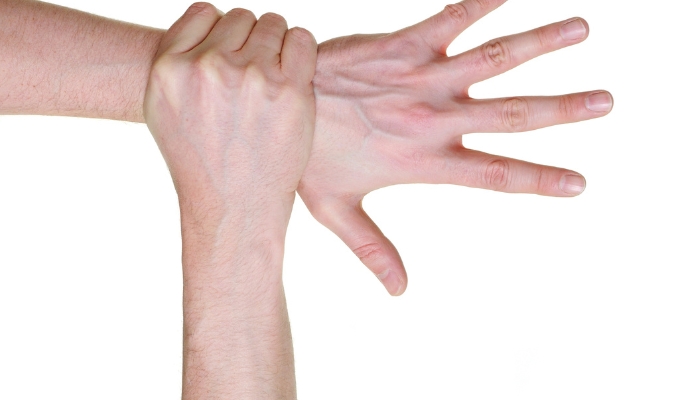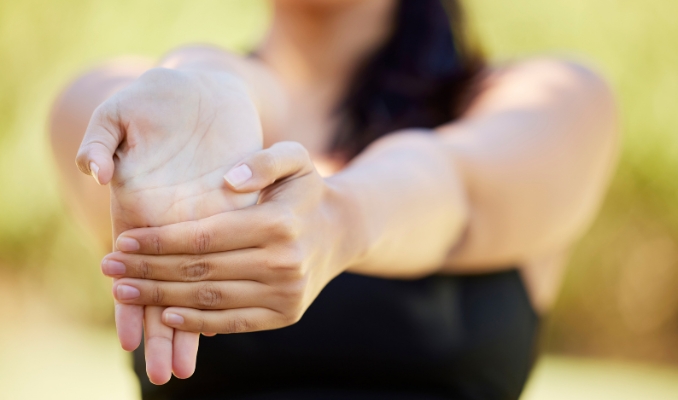Arthritis can be a formidable opponent, but there are ways to fight back and regain control of your life. In this quest of “Easy and Effective Exercises for Arthritis Pain Relief in Hands and Joints,” we embark on a path that offers relief and hope. Hand exercises for arthritis and joints, designed to be gentle yet effective, can make a difference in your daily life. So let’s discover how these exercises can bring warmth and flexibility back into your life.
Understanding Arthritis in Hands and Joints
Arthritis can negatively impact any joint, but it is especially common in the hands and joints.
There are numerous types of arthritis, but the most typical types are osteoarthritis and rheumatoid arthritis.
-
- Osteoarthritis is a wear-and-tear disease that occurs over time as the joint cartilage breaks down.
- Rheumatoid arthritis is a condition characterized by both autoimmune and inflammatory features. It causes the body’s immune system to attack the joints.
Arthritis can be frustrating and debilitating, but many things can be done to manage the symptoms and improve the quality of life.

Symptoms of Arthritis in the Hands and Joints
The most common symptoms of arthritis in the hands and joints include:
-
- Pain
- Stiffness
- Swelling
- Tenderness
- Reduced range of motion
- Crepitus (a grinding or popping sound when the joint is moved)
Diagnosis and Treatment of Arthritis
There is no cure for arthritis; more importantly, many treatments are available to help people manage their symptoms and live better lives.
Treatment options include:
-
- Over-the-counter pain relievers (ibuprofen or acetaminophen)
- Prescription pain relievers
- Prescription anti-inflammatory drugs
- Corticosteroids
- Physical therapy
- Occupational therapy
- Surgery
Living with Arthritis
Although arthritis presents challenges, there are numerous actions you can take to manage the symptoms and improve your quality of life. Here are a few tips:
-
- Get regular exercise – Exercise helps and is good for your joints. They strengthen the muscles around the joints and also improve joint function.
- Healthy weight – Maintaining a healthy wealth is also paramount as excess weight stresses the joints.
- Healthy diet – Eating a healthy and balanced diet lessens inflammation and improves overall health.
- Get enough sleep – Sleep is essential for healing and repair.
- Use support devices – like canes, walkers, and also grab bars to help you perform everyday activities more easily.
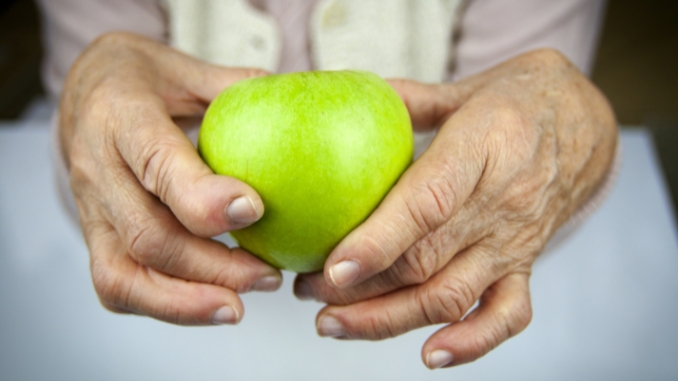
Exercises That Fights Arthritis Naturally
A. Range-of-Motion Exercises
These hand exercises for arthritis are like gentle yoga for your hands and finger joints. They help you maintain and improve the flexibility and also movement in your joints.
1. Finger Extension and Flexion
-
-
-
- Start with your hand open and your fingers straight.
- Slowly curl your fingers inwards, making a fist.
- Hold the fist position for a few seconds.
- Slowly straighten your fingers back to the open position.
- Then repeat this movement a few times on each hand.
-
-

2. Thumb Flexion and Extension
-
-
-
- Begin with your hand open.
- Gently bend your thumb towards your palm.
- Hold this position for a few seconds.
- Return your thumb to its original position.
- Then repeat the movement.
-
-

3. Make an “O”
-
-
-
- Start with your hand open.
- Touch the tip of your index finger towards the tip of your thumb to form an “O” shape.
- Hold this position for a few seconds.
- Release and open your hand wide.
- Then repeat this movement for a few times on each hand.
-
-
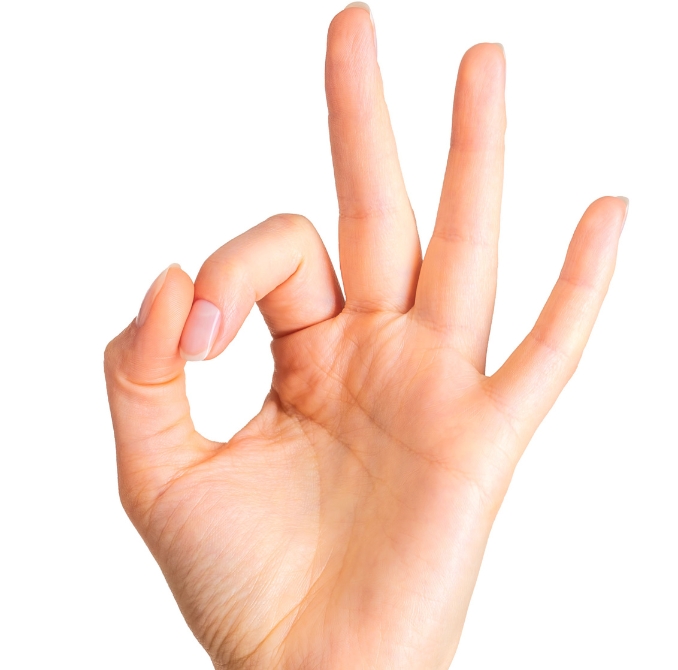
4. Wrist Flexion and Extension
-
-
-
- Sit or stand in a comfortable position.
- Place your forearm on a table or other flat surface with your hand and wrist hanging over the edge.
- Slowly bend your wrist down towards your fingers. This is wrist flexion.
- Slowly straighten your wrist back up to the starting position.
- Then repeat the movement for 10-15 times.
-
-
You can also do wrist flexion and extension without support. To do this:
-
-
-
- Stand with your arms at your sides.
- Slowly bend your wrist down towards your fingers.
- Slowly straighten your wrist back up to the starting position.
- Then repeat steps 2 and 3 10-15 times.
-
-
5. Wrist Circles
-
-
-
- Hold your hand out in front of you with your fingers extended.
- Start by making small circles with your wrist in a clockwise direction.
- After 10-15 seconds, switch to counterclockwise circles.
- Continue this motion for a few seconds on each hand.
-
-
6. MP Extension Slide (metacarpophalangeal extension)
-
-
-
- Place your good hand on a table or hold your hands, palms up.
- Place your affected fingers/hand on top of your good hand, with your fingers wrapped around the thumb of your good hand, like making a fist.
- Gently uncurl your affected hand so that only the top two joints of your fingers are flexed. Your fingers will look like a hook
- Hold the position for a few seconds, then slowly move back to your starting position.
- Switch hands and then repeat the movement.
-
-
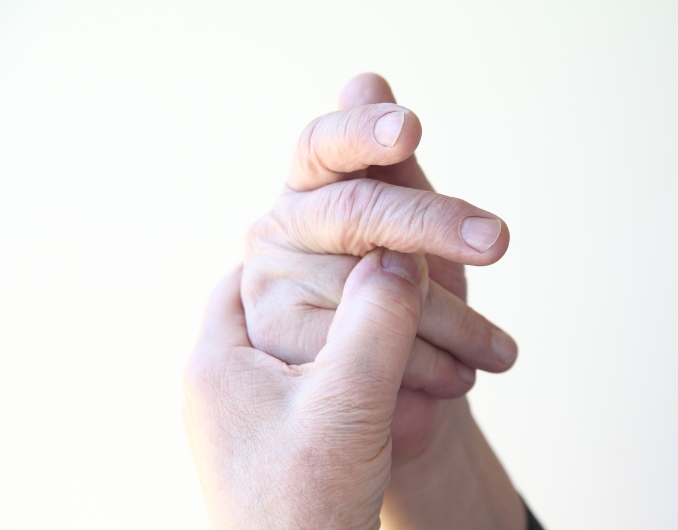
B. Strengthening Exercise
Building strength is crucial for supporting your joints and improving your grip. A simple exercise involves using a soft stress ball, putty, or hand grip to squeeze and release. It’s like a mini hand workout!
1. Hand Clench
-
-
-
- In this hand exercises for arthritis, start with your hand open and your fingers extended.
- Slowly close your hand into a fist, but not a loose fist, wrapping your thumb around your fingers. (Curl your fingers so that their top two joints are bent, and your fingers wrap down.)
- Loosen your grip to allow your fingertips to contact the palm’s base, and position your thumb so it rests gently against your index finger.
- Squeeze your hand tightly for a few seconds, feeling the tension in your palm and fingers.
- Lastly, slowly release your hand, returning to the open position.
- Then repeat this exercise a few times for each hand.
-
-
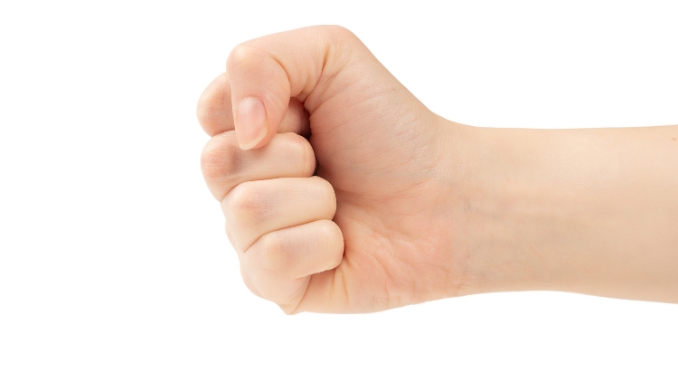
2. Thumb and Finger Lift
-
-
-
- Firstly, begin with your hand open and fingers extended.
- Secondly, lift your thumb pointing towards the ceiling, away from your fingers, trying to create as much space between them as possible.
- Then hold this position for a few breaths, focusing on the stretch.
- Thirdly, lower your thumb back down to touch your fingers.
- From the same position, lift each finger, one finger at a time, starting with the index finger and moving to the pinky.
- Lastly, hold each finger in the lifted position for a few breaths.
- Then repeat this exercise a few times for each hand.
-
-

3. Finger Spread
-
-
-
- Begin with your hand open and fingers extended.
- Gradually spread your fingers apart as wide as possible, trying to create a star-like shape with your hand.
- Hold this position for a few seconds, feeling the stretch in your palm and between your fingers.
- Slowly bring your fingers back together.
- Then repeat this exercise a few times for each hand.
-
-
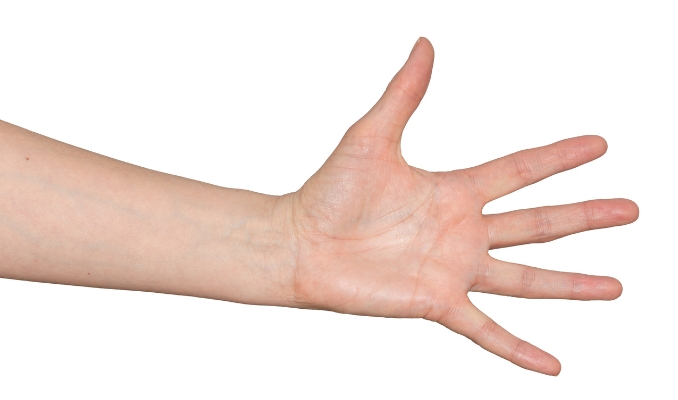
4. Putty Squeeze
You will need a small ball of hand therapy putty for this exercise.
In this hand exercises for arthritis, take the putty and roll it into a small ball in the palm of your hand.
-
-
-
- Squeeze the putty as tightly as you can without causing pain.
- Hold the squeeze for a few seconds.
- Release the putty and reshape it into a ball.
- Then repeat the squeezing motion for a few minutes with each hand.
-
-
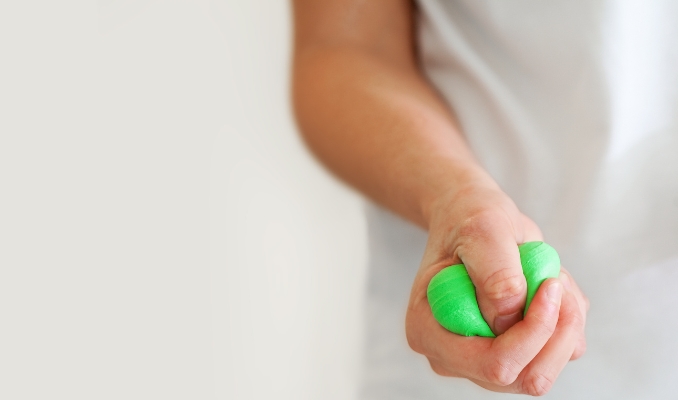
5. Finger Lift Place
-
-
-
- Place your left hand flat on a table, palm down.
- Starting with your thumb, lift each finger slowly off the table—one at a time.
- Hold each finger for a second or two, and then lower it.
- Then repeat the movement on the opposite hand.
-
-

C. Stretching Exercises
Stretching exercises are like breathing fresh air for your hands.
1. Finger Stretch
-
-
-
- Firstly, start by assuming a comfortable seated or standing position, ensuring your back is straight, and your shoulders are at ease.
- Hold your left arm straight in front of you, ideally at shoulder height, with your palm facing down.
- Secondly, depending on your comfort level, extend your fingers while trying to spread them apart.
- Hold this position as long as your body allows, feeling a gentle stretch in your fingers and hand.
- Lastly, relax and repeat the movement on the opposite hand.
-
-
2. Thumb Stretch
-
-
-
- Find a comfortable seated or standing position while maintaining good posture with your spine aligned.
- Extend your right hand in front of you, palm facing up.
- Gently bend your thumb across your palm, touching the base of your pinky finger.
- Hold this position for as long as your body allows, feeling a stretch along the side of your thumb.
- Relax and then repeat the stretch on your opposite hand.
-
-
3. Wrist Stretch
-
-
-
- Find a comfortable seated or standing position while maintaining good posture with your spine aligned.
- Extend your right arm in front of you, palm facing down.
- Gently grasp your right fingertips and also pull them downward with your left hand. You should feel a stretch along the top of your wrist and forearm.
- Hold the position for a few seconds or as long as your body allows.
- Relax and then repeat the stretch on your left hand.
-
-
4. Hand Stretch
-
-
-
- In this hand exercises for arthritis, find a comfortable seated or standing position while maintaining good posture with your spine aligned.
- Extend your right arm straight in front of you, palm facing down.
- Use your left hand to gently press your right hand’s fingers back towards your forearm.
- You should feel a stretch along the palm and the front also of your wrist.
- Hold the position for a few seconds.
- Relax and then repeat the stretch on the opposite hand.
-
-
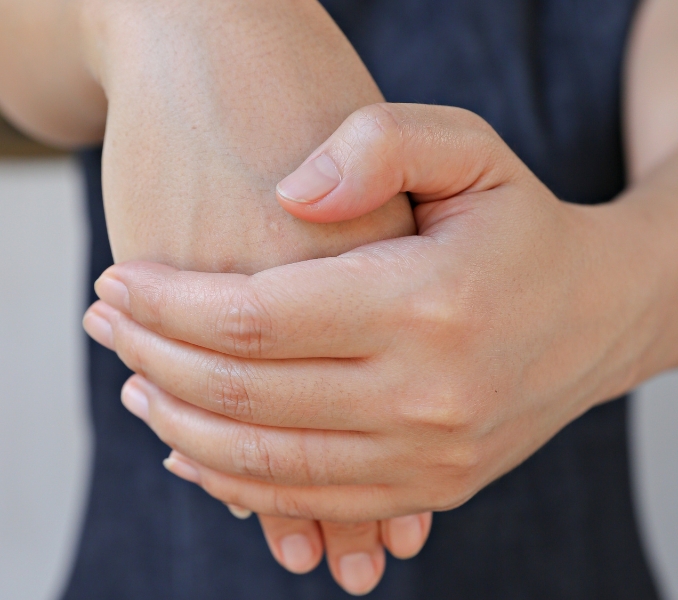
In addition to the above hand arthritis exercises, squeezing a small, soft ball, such as a tennis ball, is good for arthritis too. Here’s how to do it.
-
-
- Find a comfortable position. You can sit or stand, but make sure you have enough space to move your arms freely.
- Hold a small ball, like a stress ball, in your palm. You can use one or both hands.
- Squeeze the ball as hard as you can. Hold the squeeze for at least 5 seconds, then relax.
- Then repeat the movement.
-
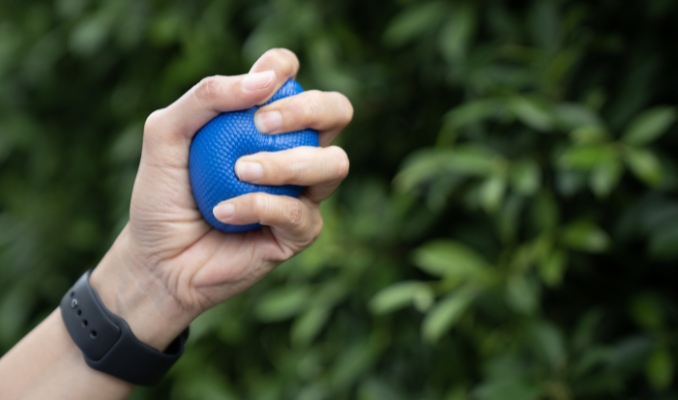
You can also move without a ball by extending your hands in front of your body, with your palms facing forward. Hold this position for 5 counts, then close your hands and hold for another 5. Relax and then repeat the movement.
Remember:
-
-
-
- Begin your exercise routine at a gentle pace and progressively enhance both the intensity and duration of your workouts as you go along.
- Do not exercise through pain.
- If you have any concerns, talk to your doctor, physical therapist, or healthcare professional before starting any new exercise program.
-
-
D. Low-Impact Cardiovascular Exercises
Low-impact cardiovascular exercises are a significant way to keep active without putting too much stress on your joints.
-
-
- Walking – This low-impact nature means it puts minimal stress on the affected joints, such as the knees and hips. Regular walking helps produce synovial fluid, lubricating the joints, reducing joint friction, and alleviating stiffness. Walking also helps strengthen the muscles around the affected joints, providing better support to the joints, reducing pain, and improving stability.
- Yoga – Yoga applies a series of gentle stretches and poses that can improve joint flexibility and range of motion, making it beneficial for people with arthritis to reduce stiffness. Enriching stability and decreasing the risk of falls, a common concern for people with arthritis, are also enhanced through yoga. Restorative or gentle yoga focuses on pain management and relieve arthritis-related discomfort
- Water Aerobics – The buoyancy of water decreases the impact on joints. This buoyancy provides a supportive and low-impact environment. Water also provides natural resistance, helping to strengthen muscles without straining the joints excessively. This resistance contributes to improved joint stability and also reduced pain.
- Swimming – When you’re in the water, the water supports your body weight, which takes the pressure off your joints. It can help improve your flexibility, range of motion, and also endurance without putting excessive strain on your joints.
- Stationary cycling – Engaging in stationary cycling provides a low-impact method to elevate your heart rate and enhance your cardiovascular health, all while minimizing strain on your joints. When riding a stationary bike, adjust the seat so that your feet are flat on the pedals and your knees are slightly bent. You should also maintain a comfortable pace and avoid pedaling too hard.
-
Vitamins To Take For Arthritis
1. Vitamin D
Although vitamin D cannot reverse arthritis, some studies indicate it may help reduce the risk of developing arthritis or alleviate its symptoms. Sunlight, fortified foods, and also supplements are sources of vitamin D.
2. Calcium
Calcium is essential for keeping strong bones and may help manage arthritis symptoms. Dairy products, fortified plant-based milk, leafy greens, and also supplements are good sources of calcium.
3. Omega-3 Fatty Acids
Omega-3 fatty acids, flaxseeds, and walnuts contain anti-inflammatory properties that may help lessen joint pain and stiffness.
4. Vitamin C
An antioxidant that supports collagen production and joint health. Citrus fruits, strawberries, bell peppers, and supplements are also good sources of vitamin C.
5. Vitamin E
Another antioxidant that may help reduce inflammation and oxidative stress in the joints. Examples of this are nuts, vegetable oils, and seeds.
6. Selenium
This essential mineral has antioxidant properties and may help reduce inflammation. This mineral can be found in foods like Brazil nuts, seafood, and whole grains.
7. Magnesium
Magnesium is paramount for nerve and muscle function, and it may help alleviate muscle pain and stiffness associated with arthritis. This can also be found in nuts, seeds, whole grains, and leafy greens.
8. Zinc
Zinc is essential for both immune system functioning and tissue repair. We can obtain zinc from red meat, poultry, beans, and also from whole grains.
9. Vitamins
Folate, B6, and B12 are also good for arthritis, are involved in various cellular processes, and may help reduce inflammation. They can be found in various foods, including meat, fish, poultry, beans, and leafy greens.
Conclusion
Hand exercises for arthritis and other joint exercises offer a powerful and accessible means to alleviate pain and also stiffness, empowering individuals to regain control over their daily lives. By incorporating the hand exercises for arthritis above into your routine, you can take proactive steps toward handling the challenges of arthritis. Patience and consistency are your allies to improved mobility and reduced discomfort.
Moreover, with dedication, you can look forward to a more colorful, more comfortable future where arthritis no longer limits your potential. Embrace these exercises as a valuable tool against arthritis, and find renewed strength and freedom.


